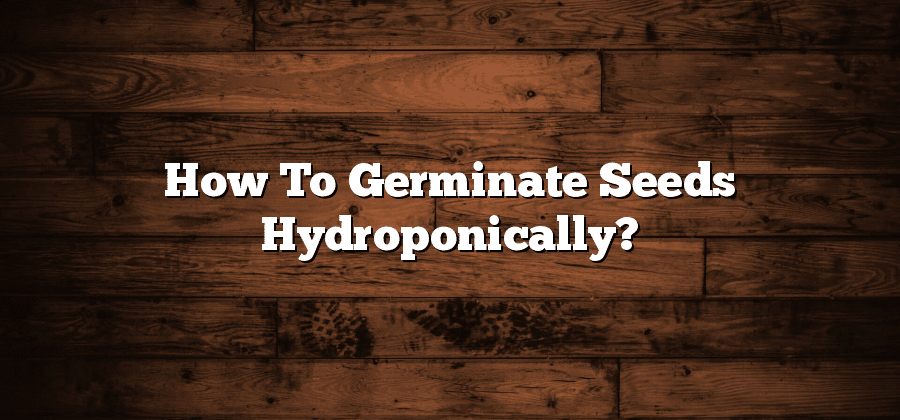Understanding the Hydroponic Seed Germination Process
Hydroponic seed germination is the process of growing plants from seeds without the use of soil. Instead, plants are grown in a nutrient-rich water solution, providing all the essential elements needed for healthy growth. This method offers several advantages over traditional soil-based germination, including more control over the growing environment, faster growth rates, and higher yields.
To initiate the hydroponic seed germination process, seeds are placed in a growing medium that retains moisture and provides support. Common growing mediums used in hydroponics include rockwool, coco coir, and perlite. Once the seeds are placed in the medium, they are carefully monitored and provided with optimal conditions for germination, including the right amount of moisture, temperature, and light. This ensures that the seeds can sprout and develop into healthy seedlings, ready to be transplanted into larger hydroponic systems for further growth.
In the next section, we will delve into the importance of selecting the right seeds for hydroponic germination, as this step plays a crucial role in the success of the overall hydroponic cultivation process.
Selecting the Right Seeds for Hydroponic Germination
When it comes to hydroponic germination, selecting the right seeds is crucial for ensuring successful growth and a bountiful harvest. While many seeds can be used in hydroponics, it is important to choose seeds that are specifically adapted to this growing method. Look for seeds that are labeled as “hydroponic” or “suitable for hydroponics,” as these have been bred or selected to thrive in a soilless environment.
Another important factor to consider when selecting seeds for hydroponic germination is the variety or cultivar. Different plants have different growth habits, nutrient requirements, and disease resistances. Therefore, it is advisable to choose varieties that are known to perform well in hydroponic systems. This information can often be found on the seed packet or obtained from reputable hydroponic gardening sources. Additionally, consider factors such as the plant’s desired final size, growth rate, and yield potential, as these will impact the overall performance within the hydroponic system.
Preparing the Hydroponic Germination Medium
To ensure successful seed germination in a hydroponic system, it is crucial to prepare the appropriate germination medium. Unlike traditional soil-based gardening, hydroponics relies on a different set of materials and techniques. One common option for the germination medium is rockwool cubes. These cubes are made from spun volcanic rock fibers and provide excellent moisture retention and aeration for the seeds. Before use, it is essential to soak the rockwool cubes in pH-balanced water for a few hours to ensure proper hydration and eliminate any residual minerals that may affect seedling development.
Another popular choice for hydroponic germination medium is perlite. Perlite is a lightweight volcanic rock with excellent water retention and drainage properties, making it ideal for promoting healthy root development. It is essential to sterilize the perlite before use to prevent potential pathogens or pests from affecting the seeds. This can be done by soaking the perlite in a 10% bleach solution and rinsing thoroughly with clean water. Once sterilized, the perlite can be placed in trays or pots, ready for seed sowing.
Providing Optimal Light Conditions for Seed Germination
To ensure successful hydroponic seed germination, providing the optimal light conditions is crucial. Light serves as a source of energy for the seeds, enabling them to kickstart the germination process. When selecting seeds for hydroponic germination, it’s important to consider their specific light requirements. While some seeds thrive in full sunlight, others may prefer partial shade or even low-light conditions. Understanding the light needs of different seeds is essential in ensuring their successful germination in a hydroponic system.
In hydroponic setups, artificial light sources are commonly used to provide consistent and controlled lighting conditions for seed germination. LED grow lights are particularly popular due to their energy efficiency and adjustable light spectrum. The intensity and duration of light exposure also play a significant role. Most seeds require a minimum of 12-16 hours of light per day to stimulate germination. It’s important to position the lights at an appropriate distance from the seeds to avoid excessive heat and damage. Additionally, regular monitoring and adjusting of the light conditions during the germination process can help promote healthy growth and development.
Maintaining the Ideal Temperature and Humidity Levels
The ideal temperature and humidity levels play a crucial role in the successful germination of seeds in a hydroponic system. It is essential to maintain these factors within the recommended range to ensure optimal growth and development of the plants.
Firstly, let’s discuss the temperature requirements for seed germination in hydroponics. Generally, most seeds prefer a temperature range of 70 to 85 degrees Fahrenheit (21 to 29 degrees Celsius). This temperature range provides the seeds with the optimal conditions necessary for sprouting and rooting. It is important to note that different seeds may have specific temperature requirements, so it is advisable to refer to the seed packet or consult a gardening guide for accurate information.
Additionally, maintaining appropriate humidity levels is equally important to support the germination process. Generally, keeping the relative humidity between 50% and 70% is recommended for successful seed germination. High humidity levels can increase the risk of fungal diseases, while low humidity levels can result in desiccation of the seeds. To maintain the desired humidity, using a humidifier or placing a water tray near the plants can help create a favorable environment for germination. Regular monitoring of the humidity levels is crucial to ensure the seeds are provided with the ideal conditions for healthy growth.
In summary, maintaining the ideal temperature and humidity levels is vital for the successful germination of seeds in a hydroponic system. By providing the appropriate conditions, you can ensure that your seeds sprout and develop into healthy plants, setting the foundation for a thriving hydroponic garden.






